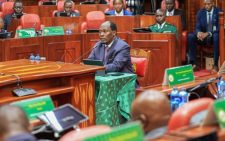How nationwide power outage hit firms, homes

Hospitals, malls, manufacturers and airports were among the critical facilities hit by a nationwide blackout that lasted for over 12 hours over the weekend, leaving huge financial losses to businesses and households.
While power, which went out on Friday night, has since been restored across major towns, there was still on and off supply in some regions by yesterday, a sign that the country was yet to fully stabilise its power grid.
But it was the blackout at the Jomo Kenyatta International Airport (JKIA) – the country’s major entry point – that triggered major concern over possible security threats after backup generators also failed, affecting international flights because passengers and cargo could not be cleared.
Transport Cabinet Secretary (CS) Kipchumba Murkomen later clarified the incident did not pose any significant danger since there was no “iota of darkness” on JKIA’s runway and control towers. Two new generators are now expected to be commissioned at the airport in coming weeks to retire the existing old ones, which currently have a combined capacity of 2.16 Megavolt Ampere.
The aftermath of the blackout and failed generator left a boardroom shakeup as Kenya Airport Authority’s (KAA’s) Managing Director Alex Gitari and Fred Odawo, General Manager Project and Engineering Services, got axed immediately.
Business leaders say the frequent blackouts are limiting economic growth. Power outages have a huge impact on manufacturers’ production lines, sometimes causing breakdowns to the machines and spoiling goods. There are also additional costs as industry players must buy fuel to power their alternative.
Frequent blackouts
Kenya Power and Lightning Company (KPLC) blamed the latest blackout, which followed a similar one last March, on “system disturbance.”
However, it later emerged there was a bulk supply cut of Lake Turkana Wind Power which tripped due to technical hitches, shutting down the grid’s systems and the rollover impact shutting down other power plants.
Attempts to tap power from Uganda through the high-voltage Lessos-Tororo transmission line to rectify the situation also failed. Kenya and Uganda rely on each other for extra power during emergencies and shortfalls.
“We normally use Uganda to back feed and start up our system. Unfortunately, yesterday and a few days ago, Uganda line to Kenya has been down because some of the six towers on Uganda side has been down,” explained Energy CS Davis Chirchir.
By the time of the power cut, LTWP was feeding about 270 Megawatts (MW) into the national grid, just when the network was gradually starting to come off-peak.
The government is yet to establish the exact reason behind LTWP’s fault but Chirchir dismissed the reduction in wind speed as the cause since such incidents are often gradual and with very minimal interruption.
“We do not see any more challenge except correcting the problem that caused the challenge from Lake Turkana and going forward we want to basically look at investment in our network and maintenance,” added Chirchir.
KPLC started to bring back heavy users, mainly industries, on Saturday and Sunday though small businesses such as barbershops, entertainment joints, restaurants, and residential remained affected by the instability of the network. They resorted to expensive diesel-powered generators to operate and minimise business losses.
National Assembly’s Committee on Energy has since summoned Chirchir and Kenya Power chief executive Joseph Siror to explain the circumstances that led to the blackout. Attempts to compel Kenya Power to compensate businesses whose power is cut off for more than three hours within a day have previously been rejected by the government.
The directive would have piled pressure on Kenya Power which is currently facing fresh liquidity challenges, partly due to system losses and costly bulk power. Sector players have several times called for an end to KPLC’s monopoly to create alternatives for consumers and improve electricity reliability.












